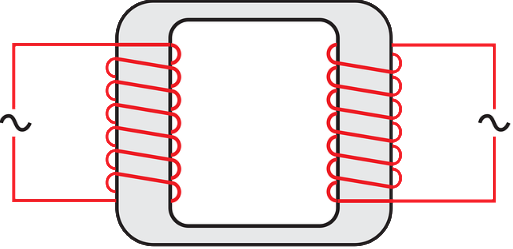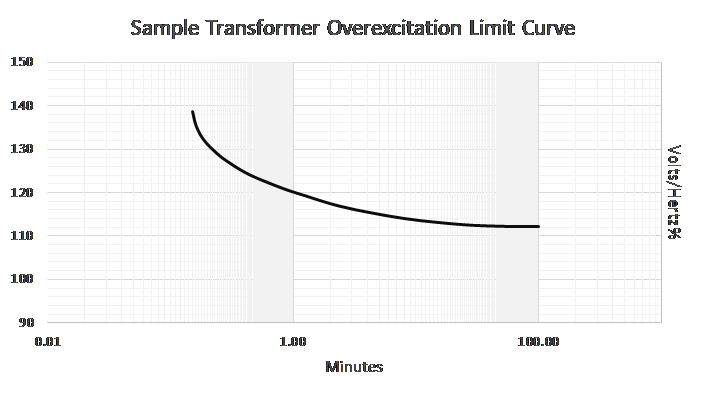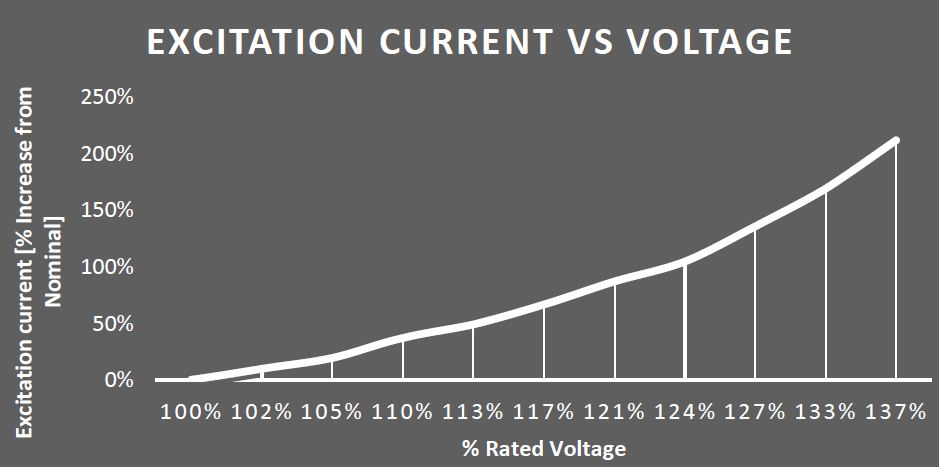Power transformer can saturate when voltage to frequency ratio for the particular transformer design is violated. Transformer is said to be saturated or overexcited when its core can no longer carry flux that is being generated. When core is saturated, the magnetizing impedance drops to its air core value. Overexcitation is a major concern on directly connected generator connected transformers, transformer connected to distributed generation units such as solar and wind.

Industry standards (ANSI/IEEE C37.91, C37.102) states that saturation (overexcitation) occurs when the ratio of voltage to frequency (V/Hz) applied to transformer terminals exceed 1.05 per unit at full load 80% power factor or 1.1 per unit at no load.
Transformers are subject to thermal damage due to saturation. Methods to disconnect transformer from circuit when saturation induced overexcitation occurs should be employed. Similar to transformers, generators are also subject to overexcitation. Typically, ANSI 24 (Volts/Hz) element is used to detect overexcitation.
Two conditions that has most impact on saturation are:
1) Overvoltage operation 2) Under frequency operation
Overvoltage can occur during load rejection after a system disturbance or an unloaded transformer at the end of a long line or underground cables due to Ferranti Effect.
Under frequency can occur due to malfunctioning generator regulator or when load exceeds generation capacity. Under frequency can lead to extreme winding overheating.

Example of transformer excitation curve is shown in figure 1. Per this graph at Vols/Hertz ratio of 120%, transformer damage could occur in 1 minute. Permissible short time overexcitation capability of a specific transformer or generator should be obtained from the manufacturer.
Does high load current cause transformer to saturate?
It is important to realize that unlike an inductive circuit, higher load current DO NOT translate into more core flux in a power transformer! In fact, in a power transformer (except for leakage flux) the core flux remains constant with load. A popular misconception is that an overloaded or a highly loaded transformer can saturate which is not true.
Flux density in the core is proportional to:

It can be seen that the core flux is determined by a) Primary voltage b) Supply frequency. Flux density is directly proportional to voltage and inversely proportional to frequency. Either an increase of voltage or decrease of frequency can lead the transformer core to saturate at which point we can call the transformer as ‘overexcited’.
What happens when power transformer is saturated?
Saturated (overexcited) transformer is susceptible to thermal damage from excitation current. Excessive core flux can increase inter-lamination voltages causing iron damage (burning, pitting). Figure 2 shows results of a lab experiment with a small control power transformer with no load secondary. As can be seen the excitation current increase almost exponentially after around 110% nominal voltage is applied. These large currents will overheat the transformer and can cause permanent damage.

The overflow flux (flux that cannot circulate in the core) will spill into locations where flux was not designed such as structural parts, leads etc. resulting in eddy current heating. Note that there is some margin for overexcitation due to the large thermal time constant of typical power transformer or in other words short term overvoltage due to switching is unlikely to cause issues.
Saturated transformers produce odd-order harmonics (primarily 5th) which can appear as differential current to transformer differential relay. Sometimes this could be a problem because during Generator Step Up (GSU) transformer energization process the voltage and frequency may vary for a short duration overexciting the transformers. To avoid differential relay (87) tripping, provide 87 relays with a fifth harmonic block.
How to protect transformer from overexcitation or saturation?
Critical parameter to monitor is volts per hertz (V/Hz) since core flux is proportional to this ratio. For almost all transformers, damage occurs at a V/Hz level of 1.25pu [ref 1]. Overexcitation protection is recommended for transformers that are susceptible to voltage or frequency variation. Example of this would be Generator-Transformer (GSU) unit or transformer connected to a solar or wind generation systems.
ANSI 24 relay element should be used to protect against saturation. ANSI 24 (V/Hz) protection setting or curve for the relay need to be coordinated with specific transformer or generator overexcitation withstand capability curve obtained from the manufacturer.
Read: Transformer Excitation Current
Ref [1] https://store.gegridsolutions.com/faq/documents/T60/GET-8434.pdf
